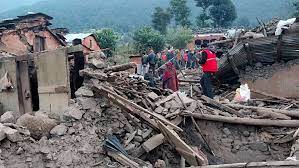
A 5.6 magnitude earthquake struck Nepal, triggering widespread panic and rattling the National Capital Region (NCR) in India. The tremors, felt on Monday, were a consequence of an aftershock from the 6.4 magnitude earthquake that had shaken Nepal on November 3, marking one of the strongest seismic events the region has experienced since 2015.
The National Centre for Seismology reported the quake, which had its epicenter located 233 kilometers north of Ayodhya in Uttar Pradesh. The quake struck at 16:16:40 IST, with coordinates indicating a latitude of 28.89 and longitude of 82.36, occurring at a depth of 10 kilometers. The tremors were felt for approximately 10 seconds in Delhi and the surrounding National Capital Region, causing widespread anxiety and vigorous shaking of furniture among residents.
Sanjay Kumar Prajapati, a scientist at the National Centre for Seismology, stated, “Another earthquake has hit Nepal. The magnitude of the earthquake is 5.6…this is an aftershock of the earthquake that happened on November 3. So far, 14 aftershocks have come, and this was the one with the highest magnitude so far.”
Nepal’s vulnerability to earthquakes has been a recurrent concern due to its location in one of the most active tectonic zones in the world, classified as seismic zones IV and V. The country’s geographical position makes it susceptible to seismic activity, with aftershocks typically following significant earthquakes.
The recent 6.4 magnitude earthquake in Nepal had resulted in significant loss of life, with 153 people confirmed dead and 160 injured. A subsequent revision by authorities in Nepal clarified the death toll to 153, attributing the discrepancy to name duplication. The epicenter of the initial quake was in Jajarkot, where 105 deaths were initially reported, while 52 deaths occurred in Rukum West district.
The latest aftershock, while less severe in terms of magnitude, has further intensified concerns about the region’s vulnerability to seismic activity and the potential for more aftershocks in the coming days. Both Nepal and the National Capital Region of India remain on high alert, prepared to respond to any potential consequences of these natural disasters.
The events of the past few days serve as a stark reminder of the ever-present threat of earthquakes in this part of the world, urging authorities and communities to continue investing in disaster preparedness and mitigation efforts to minimize the impact of such geological events.
Sources By Agencies


